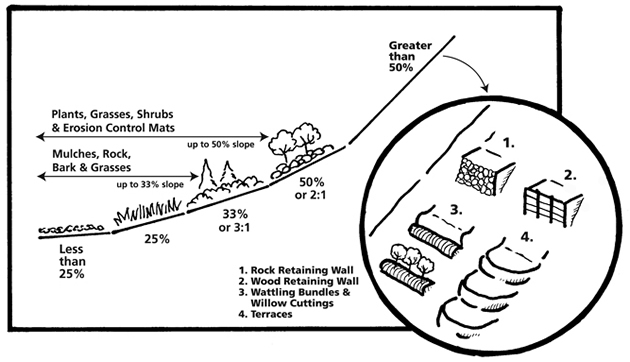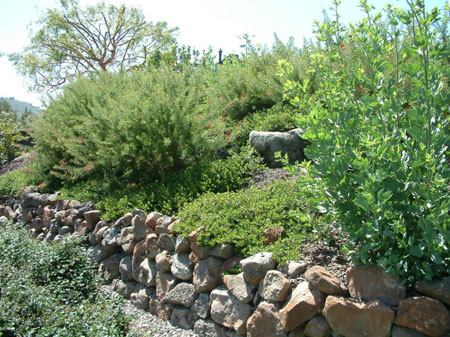- TABLE OF CONTENTS
- REDUCE YOUR WATER NEEDS
- Use Drought Tolerant Plants
- California Native Plants
- Climate Zones
- Reduce or Replace Lawn
- Artificial Turf
- IRRIGATE EFFICIENTLY
- Water Needs of Plants
- Before You Design
- Types of Irrigation Systems
- Weather Based Irrigation Controllers
- Working with an Irrigation Contractor
- DEVELOP ALTERNATE SOURCES OF WATER
- RETAIN WATER IN THE LANDSCAPE
- Build Retaining Walls
- Mulch to Reduce Evaporation
- Install Permeable Hardscapes
- Amend Soil with Organic Materials
- KEEP YOUR WATER PURE
- Drainage
- Eliminate Runoff and Overspray
- Slow it, Spread it, Sink it
- Ocean Friendly Gardens
- Rain Gardens
- Swales
- Keep Your Watershed Beautiful
- Soil
- Pests
- Select Plants that Don't Need Chemicals
- ADDITIONAL GARDENING RESOURCES
Build Retaining Walls
Build Retaining Walls and Terracing (from Slow it, Spread it, Sink it! A Homeowner’s Guide to Greening Stormwater Runoff, Resource Conservation District of Santa Cruz County)
Uses: SLOPED AREAS
Protecting steep slopes is very serious! Improperly installed systems can pose a serious threat to life and property. We recommend that ALL retaining wall and terraced areas be designed and installed by a licensed qualified professional.
Retaining walls and terraces protect your garden against erosion by reducing the gradient or slope and providing level or gently sloping areas for establishing vegetation. Retaining walls and terrace walls are constructed with boulders, treated timber, bricks and/or interlocking concrete blocks. (Walls over 3 feet high must be designed by an engineer). There are MANY different types of retaining walls, each with a different purpose, so always check with a qualified professional before embarking on any wall project for soil retention. A building permit and engineering expertise are required to build many retaining walls. Always check with your Santa Cruz County planning department to determine if a permit is necessary for your project. County of Santa Cruz Planning Department 831-454-2580 www.co.santa-cruz.ca.us

RETAINING WALLS
Rock retaining walls are an alternative to wood retaining walls and are often used next to a roadway or drainage way. They are freestanding walls built from rock 10 inches to 2 feet in diameter. A footing trench is dug along the toe of the slope, and the largest boulders are placed in the trench. Subsequent rocks are laid with at least three bearing points on previously laid rocks. The external face of the wall should incline slightly uphill, though the wall itself is freestanding and does not lean. As the wall is built, fill material is placed around and behind the rocks and packed in. Since the finished slope behind the wall will be flatter than before treatment, possibly a level terrace, it should be easier to establish all-important perennial plants on and above the wall.
 |
Wood retaining walls can be used on slopes steeper than 50 percent and are often located between the base of a slope and an adjacent road, driveway or drainage way. Lumber and posts should be treated with an approved wood preservative (not creosote). Ensure proper drainage methods behind the wall are utilized. As always, vegetation should be established on the slope above the wall.
TERRACES
Many materials are available for building terraces. Treated wood is easy to work with, blends well with plants, and is often less expensive than other materials. Interlocking concrete blocks are made specifically for walls and terraces and are more easily installed by a homeowner than other materials, such as fieldstone and brick. The steepness of the slope dictates wall height. Make the terraces in your yard high enough so the land between them is close to level. This soil surface should be carefully revegetated. Be sure the terrace material is strong and anchored well to stay in place through cycles of freezing, thawing, and heavy rainstorms. Large terraces should be tied back into the slope and properly drained. This takes expertise and equipment, so you may want to restrict the terraces you build to a foot or two in height. Get help from a professional to make sure higher walls stand up to the forces of gravity and water pressure in the soil.
DON’T
• Install without checking on permit requirements.
• Use creosote-treated wood.
DO
• Provide adequate drainage behind retaining walls.
• Use a qualified professional to design your wall.